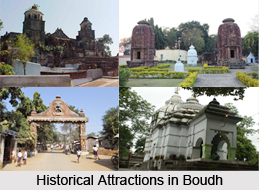 Boudh city was made the headquarters of the new district of Boudh by the then Chief Minister Biju Pattanaik, during whose tenure the old Phulbani district was split in January 1994.
Boudh city was made the headquarters of the new district of Boudh by the then Chief Minister Biju Pattanaik, during whose tenure the old Phulbani district was split in January 1994.
Early History of Boudh
The early history of Boudh is still in obscurity. However, the discovery of remarkable Buddhist statues from Boudh led some scholars to believe that Boudh was an important Buddhist centre of Odisha. From the epigraphic records it is known that in the middle of Eighth Century A.D. Boudh was under the occupation of the Bhanja rulers and was a part of Khinjali Mandala. The earliest known ruler of this Bhanja family was Nettabhanja who was ruling over the Dhenkanal region as independent ruler, but his successor migrated towards Boudh-Sonepur region and established Khinjali Mandala and ruled there as the feudatory of the Bhauma Karas of Tosali. The Sonepur District Copper Plate of Satrubhanja Dev, son of Silabhanja mentions the name Khinjali Mandala for the first time and on this basis it is believed that Silabhanja Dev was the founder of Bhanja Kula of Khinjali Mandala. Their capital was Dhirtipura, which has been identified with Boudh town. Satrubhanja Dev - II, a ruler of this family was defeated and killed by the Somavansi ruler of South Kosala, Janmeyjaya - I. The Bhanja"s were driven out from the Boudh region which was renamed as Odra Desa. King Yayati -I, the son and successor of Janmejaya-I established his capital in Odradesa at Yayatinagara, which has been identified with modern Jagati in Boudh District. The Somavansi then occupied and migrated towards Utkala leaving their original home land South-Kosala in charge of viceroys. In course of time Kosala was lost to them and was occupied by the Telugu-Chodas and the Kalachuris.
Medieval History of Boudh
Medieval History of Boudh defines the rule of Eastern Ganges Dynasty. Gangas of Kalinga, after their occupation of Utkala, entered into a protracted struggle with the Kalachuris for one hundred years for the occupation of Kosala region. It is evident from the Chatesvar Inscription (1220 AD) that the struggle finally ended in favour of the Gangas during the region of Anangabhima Deva – III and thereafter Boudh along with Sonepur came under the Ganga rule and was administered by the administrators of Ganga. In course of time, the Ganga Administrators became semi-independent and ruled over this territory hereditarily. So far tradition goes; there emerged a Brahmin ruling family in Boud. Gandhamardan Dev, the last Brahmin ruler of this family, being childless adopted one Ananga Bhanja of Keonjhar Bhanja royal family. He succeeded Gandharmardhan Dev and laid the foundation of the rule of the Bhanjas in Boudh in the first half of fourteenth century AD. He changed his surname from Bhanja to Dev and was known as Ananga Dev.
Modern History of Boudh
The line of kings of Ganges Dynasty continued to rule over this region till the merger of Boudh State with the Odisha province in 1948. Their kingdom comprised modern Athmallik, Boudh and Sonepur regions with its capital headquarters at Swarnapura (Sonepur). But later on due to the expansionist policy followed by the Chouhan rulers of Patna (Patnagarh in Bolangir District) they shifted their capital to Boudh.
Related Articles
Odisha
Tourism in Odisha
Ganga River
Boudh District
Patna
Bihar
Dhenkanal District



















